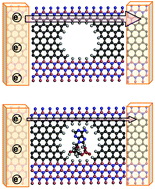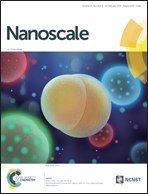Electrical detection of nucleotides via nanopores in a hybrid graphene/h-BN sheet
Abstract
Designing the next generation of solid-state biosensors requires developing detectors which can operate with high precision at the single-molecule level. Nano-scaled architectures created in two-dimensional hybrid materials offer unprecedented advantages in this regard. Here, we propose and explore a novel system comprising a nanopore formed within a hybrid sheet composed of a graphene nanoroad embedded in a sheet of hexagonal boron nitride (h-BN). The sensitive element of this setup is comprised of an electrically conducting carbon chain forming one edge of the nanopore. This design allows detection of DNA nucleotides translocating through the nanopore based on the current modulation signatures induced in the carbon chain. In order to assess whether this approach is feasible to distinguish the four different nucleotides electrically, we have employed density functional theory combined with the non-equilibrium Green's function method. Our findings show that the current localized in the carbon chain running between the nanopore and h-BN is characteristically modulated by the unique dipole moment of each molecule upon insertion into the pore. Through the analysis of a simple model based on the dipole properties of the hydrogen fluoride molecule we are able to explain the obtained findings.



 Please wait while we load your content...
Please wait while we load your content...